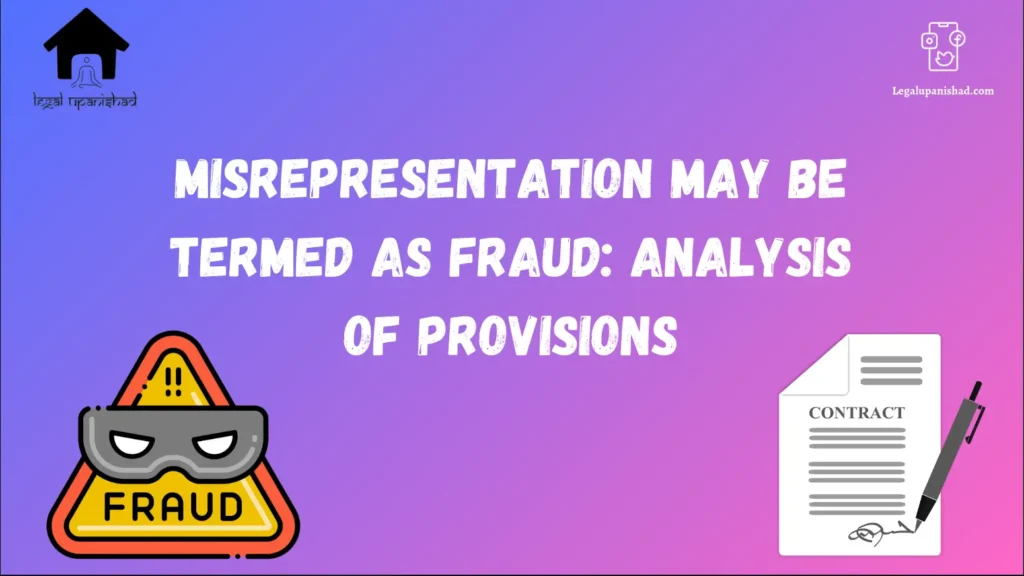This article on ‘Misrepresentation: Analyzing Provisions for Potential Fraud’ was written by Tosani Lal, an intern at Legal Upanishad.
INTRODUCTION
In the world of legal matters especially in the subject of contract law. Misrepresentation and fraud are although different elements of contract act that helps in establishing the intention of a person.
Misrepresentation can be defined as “the positive assertion, in a manner not warranted by the information of the person making it, of that which is not true, though he believes it to be true;
(2) any breach of duty which, without an intent to deceive, gains an advantage to the person committing it, or any one claiming under him; by misleading another to his prejudice, or to the prejudice of any one claiming under him;
(3) causing, however innocently, a party to an agreement, to make a mistake as to the substance of the thing which is the subject of the agreement.”
While Fraud “means and includes any of the following acts committed by a party to a contract, or with his connivance, or by his agent, with intent to deceive another party thereto of his agent, or to induce him to enter into the contract
(1) the suggestion, as a fact, of that which is not true, by one who does not believe it to be true;
(2) the active concealment of a fact by one having knowledge or belief of the fact;
(3) a promise made without any intention of performing it;
(4) any other act fitted to deceive;
(5) any such act or omission as the law specially declares to be fraudulent.”
Both these terms are often used in an interchangeable manner depending on the circumstance of the case. In this article, we will try to comprehend the nature of misrepresentation and delve into ourselves to answer the critical question of whether misrepresentation can be termed as fraud.


UNDERSTANDING MISREPRESENTATION
As discussed before in contract law misrepresentation refers to an action of negligence with regard to disclosure of material facts to the other party or making an innocent false statement. For example, a university falsely claimed that it was affiliated with the requisite authorities established by the Indian Government. Supreme Court of India held that such an act amounts to misrepresentation and unfair trade practice as per defined under the Competition Act,2002. In order to understand the nature of misrepresentation it’s pertinent to know the various key elements of actionable misrepresentation and also various types of misrepresentation which are as follows
KEY ELEMENTS OF MISREPRESENTATION
Unwarranted Statement
When a person knowingly provides false claims about a certain fact then such statements are referred to as unwarranted statements. In such situations when the representation is perceived as a settlement provision then later the party who shall be aggrieved due to disclosure of such statement being false cannot avoid it. However, they can seek relief by claiming for damages caused by such statements. For example, a shopkeeper making claims that a certain product is guaranteed to provide a reduction in ageing without any reasonable basis can be termed as an unwarranted statement.
Breach Of Duty
A misrepresentation made by any person due to actions amounting to negligence that may be advantageous to that person who made such representation to the other party. In other words, when a person wilfully neglects his duty to perform the contract and does not act with reasonable care then such actions amount to breach of duty. For example, when a party who is a buyer refuses or delays payments without providing any reason as to such refusal or delay then such an action can amount to a breach of duty.
Inducing Mistakes About Subject-Matter
When one party in a settlement unintentionally prompts another party to make an action that amounts to a mistake with respect to the substance of the element that is the main agenda of the settlement. In other words, the error in that fact amounts to a mistake about the subject. Such errors take place when the parties are not in consensus ad idem or have a miscommunication resulting in misunderstanding. Such mistakes can be divided into two parts-
- Bilateral Mistake: Bilateral mistakes take place when both parties have together acted in a manner that results in the violation of the contractual agreement with respect to the terms outlined in the agreement. Such an action results in nullifying the agreement making it void because of lack of consent however, for an action that amounts to error which results in the contract being void it shall be an error of material truth which is essential for the contract. Therefore, any kind of misunderstanding, omission, miscommunication, or ignorance with respect to the subject matter such as the title, quotation, quality etc.
- For instance, Party A and Party B are in agreement to sell and purchase a horse but unknown to Party A the horse is of unsound mind. Therefore, in such circumstances, the agreements shall be rendered void due to the factual error made by both parties.
- Unilateral Mistake: Unlike the bilateral mistake, in the case of a unilateral mistake, only one party’s action causing error with respect to the facts can amount unilateral mistake. However, in such cases, the agreement is rendered voidable which means it can be still enforceable if both parties consent to still agree to continue the contract. For example, Party A and Party B entered into a contract for the sale of a radio device for a consideration of Rs.260. Later on Party A by mistake paid only 250 rupees now, it’s up to the discretion of Party B whether they still wish to pursue the agreement or cancel the transaction.
TYPES OF MISREPRESENTATION
- Fraudulent Misrepresentation: When a person makes a false representation with the knowledge that such a statement is actually untrue or was reckless as to whether such statements made is actually correct or not it shall be regarded as fraudulent misrepresentation as there is a lack of accuracy and honesty by the person who made such as statement. Therefore, an important ingredient in making a statement as a false representation is the dishonest and ingenue intention of the person making such a statement.
- Negligent Misrepresentation: When one party makes a statement negligently or without any reason to believe that such a statement is true then such an action amounts to negligent misrepresentation. In other words, when a party acts in a manner that results in influencing the other party to enter into a contractual agreement then such a party that is inducing the other party has the duty to care that the statement made by them is correct and based on the justifiable reason. Such cases of negligence occur when a party has not taken due care and acted recklessly while making statements which is inaccurate and false which creates an unwarranted statement.
- Innocent Misrepresentation: When a party innocently misrepresents the facts of the case that means the statements, they are claiming to be accurate are in actually incorrect by the party has no knowledge about the same then such statement is rendered as innocent misrepresentation.
LEGAL REMEDIES
- Rescind: The revocation of a contract is referred to as rescind. The aggrieved party as requested the other party to terminate the contract and seek damages that have been borne by them due to false misrepresentation. Therefore, this rescind means to dissolve the contract and place the parties in the same situation as they were before the commencement of the contract.
- Demand the performance: The aggrieved party that has suffered the damages due to misrepresentation of the facts can request to obtain the object of the contract.
RELATIONSHIP BETWEEN MISREPRESENTATION AND FRAUD
Misrepresentation and fraud are interchangeable terms, but they do not mean the same in contract law. The nexus between misrepresentation and fraud describes the intention or the mindset set by the person to perform an act with such intent that eventually results in the transition from innocent or negligent into intentional deception for material gain.
Therefore, having an innocent or committing negligence action can lead to the establishment of setting a stage for the commission of fraud. In such situations, the person who makes such statements is based on two circumstance that is it could be made when he or she believe it to be accurate or incorrect due to lack of information on the subject matter. Therefore, the key connection between misrepresentation and fraud is that misrepresentation alone may not be tantamount to fraud, but it definitely fuels the engine that is required to set fraud in acceleration mode especially when it is geared with intention.
The key element the one needs to observe while determining whether misrepresentation can amount to fraud is the intention of the party who makes such a statement. If the statement is made with genuine intention, then such statements may not amount to fraud on the other hand if such claims are made by a person with the knowledge that such claims are false or they do not have a strong basis to know whether such statement is true and correct then such misrepresentation shall amount to fraud as well.
The intention is the source of the evolution of the transition from the act of misrepresentation to a fraudulent act. While observing such transition there is clear evidence that there is an element of malice that had started from clear misinformation.
CONCLUSION
The misrepresentation is act of providing wrong information to another person by claiming it to be true. Such action can either be due lack of knowledge or even having sufficient knowledge that such a statement is false but still presenting the statement in a fashion to be true. When a person knows the truth of the facts to be false and actively conceals it in order to show that such a statement is true such an action amounts to fraud. Therefore, the evolution from misrepresentation to fraudulent acts requires male-fide intention.
REFERENCES
- The Indian Contract Act, 1872
- Buddhist Mission Dental College and Hospital v. Bhupesh Khurana, (2009) 02 SC CK 0136
- ‘Misrepresentation What Statements Will Establish a Claim’, Lexis Nexis, available at : www.lexisnexis.co.uk/legal/guidance/misrepresentation-what-statements-will-establish-a-claim

